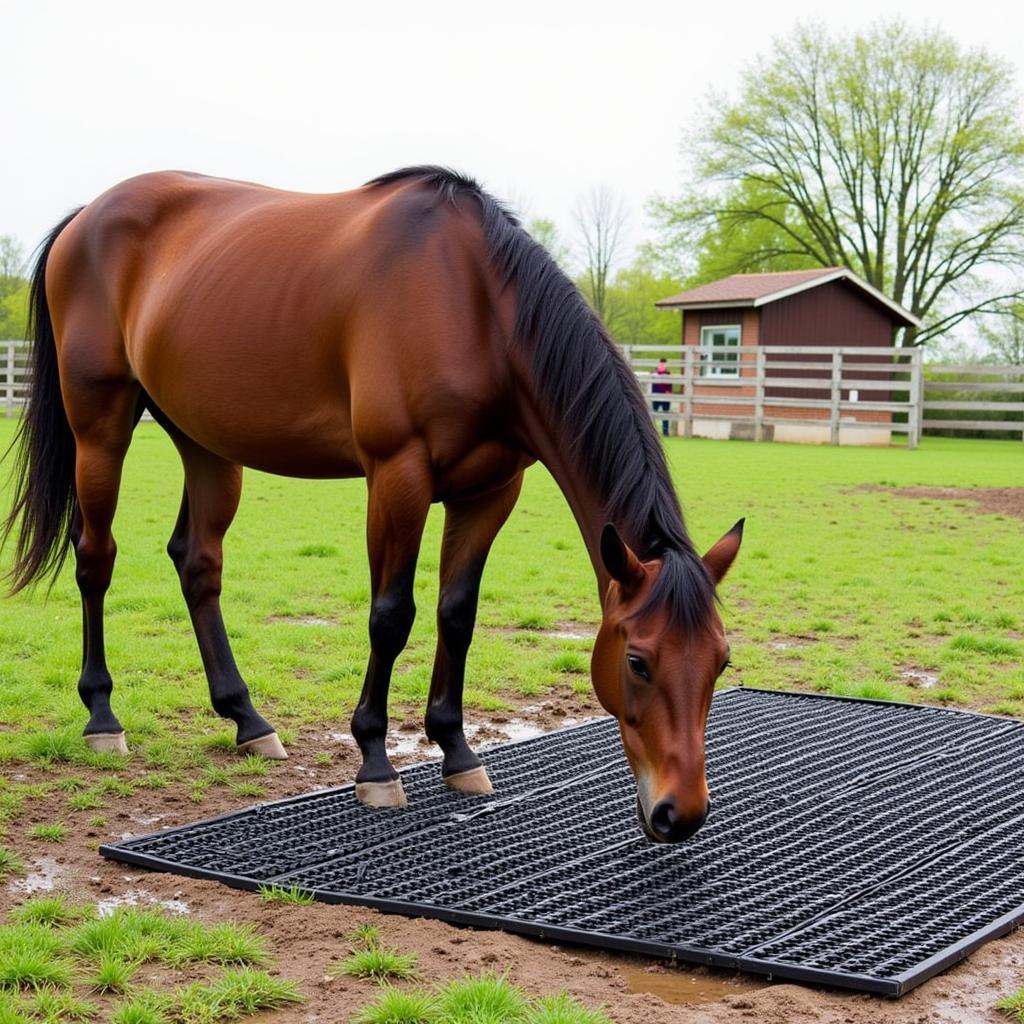Horse Paddock Mud Control Grids are essential for maintaining a healthy and safe environment for your equine companions. Muddy paddocks can lead to a host of problems, from hoof issues and injuries to general discomfort and unsanitary conditions. This guide will explore the benefits, installation, and maintenance of horse paddock mud control grids, empowering you to create a dry and comfortable space for your horses.
Why Invest in a Horse Paddock Mud Control Grid System?
Muddy paddocks are more than just an inconvenience; they pose serious threats to your horse’s health and well-being. Standing water can breed bacteria and parasites, leading to thrush, skin infections, and other health issues. Deep mud can cause horses to slip, strain tendons, and even break bones. A mud control grid system minimizes these risks, providing a stable, dry surface year-round. It also helps prevent erosion and keeps your paddock looking neat and professional.
How Mud Control Grids Work
Mud control grids work by creating a permeable surface that allows water to drain away while providing a stable footing for your horses. The grid structure supports the weight of the horse, distributing it evenly and preventing the ground from becoming compacted and muddy. The open spaces within the grid allow grass to grow through, maintaining a natural look while still offering the benefits of a dry surface.
Choosing the Right Horse Paddock Mud Control Grid
There are various types of mud control grids available, each with its advantages and disadvantages. Consider factors such as your budget, the size of your paddock, and the specific needs of your horses. Some common materials include:
- High-density polyethylene (HDPE): Durable, lightweight, and easy to install.
- Gravel grids: Offer excellent drainage but can be more challenging to install.
- Rubber mats: Provide a comfortable surface but can be expensive.
Key Considerations for Grid Selection
When choosing a grid, think about the weight it needs to bear (consider heavy equipment like tractors if you use them in your paddock), the climate (extreme temperatures can affect some materials), and the ease of maintenance.
 Comparing Various Mud Control Grid Types
Comparing Various Mud Control Grid Types
Installing Your Horse Paddock Mud Control Grid
Proper installation is crucial for the effectiveness and longevity of your mud control grid. Follow the manufacturer’s instructions carefully. Generally, the process involves preparing the ground, laying down a geotextile fabric to prevent weeds, and then assembling the grid pieces.
Step-by-Step Installation Guide
- Clear the area and level the ground.
- Lay down a geotextile fabric.
- Assemble the grid pieces according to the manufacturer’s instructions.
- Fill the grid with your chosen surface material (e.g., gravel, sand).
- Compact the filling material.
“Proper installation is paramount to the success of your mud control grid. Take the time to prepare the ground correctly, and don’t cut corners,” advises Dr. Emily Carter, DVM, equine veterinarian and paddock management specialist.
Maintaining Your Horse Paddock Mud Control Grid
Regular maintenance will ensure your grid remains effective for years to come. Remove manure and debris regularly to prevent clogging and maintain a sanitary environment. Inspect the grid periodically for any damage and repair or replace any broken pieces promptly.
Keeping Your Grid in Top Condition
- Remove manure daily.
- Clear debris regularly.
- Inspect for damage and make repairs as needed.
“Regular cleaning is essential not just for the aesthetics of the paddock, but also for the health of your horses. A clean grid minimizes the risk of bacterial growth and infections,” explains John Miller, a renowned horse farm manager with over 20 years of experience.
 Horse Enjoying a Mud-Free Paddock
Horse Enjoying a Mud-Free Paddock
Conclusion
Investing in a horse paddock mud control grid is a smart investment in your horse’s health and well-being. By creating a dry, stable surface, you can minimize the risk of injuries and illness while maintaining a clean and aesthetically pleasing paddock. Choose a high-quality grid, install it correctly, and maintain it regularly to ensure its longevity and effectiveness. With a mud control grid, your horses can enjoy a comfortable and healthy environment year-round.
FAQ
- How much does a horse paddock mud control grid cost? The cost varies depending on the size of your paddock and the type of grid you choose.
- Can I install a mud control grid myself? Yes, many grids are designed for DIY installation.
- What is the best type of filling for a mud control grid? Gravel and sand are common choices.
- How long does a mud control grid last? With proper maintenance, a high-quality grid can last for many years.
- Is a mud control grid worth the investment? Absolutely, it protects your horse’s health and can save you money on vet bills in the long run.
- What are the alternatives to mud control grids? Other options include French drains and improved drainage systems, but grids offer a more comprehensive solution.
- Can I use a mud control grid in a high-traffic area? Yes, choose a heavy-duty grid designed for high traffic.
Need help with mud control? Check out our other articles on paddock management and horse care. Looking for specific grid recommendations? Browse our product selection.
When you need support, contact us at Phone Number: 0772127271, Email: [email protected] Or visit us at: QGM2+WX2, Vị Trung, Vị Thuỷ, Hậu Giang, Việt Nam. We have a 24/7 customer service team.